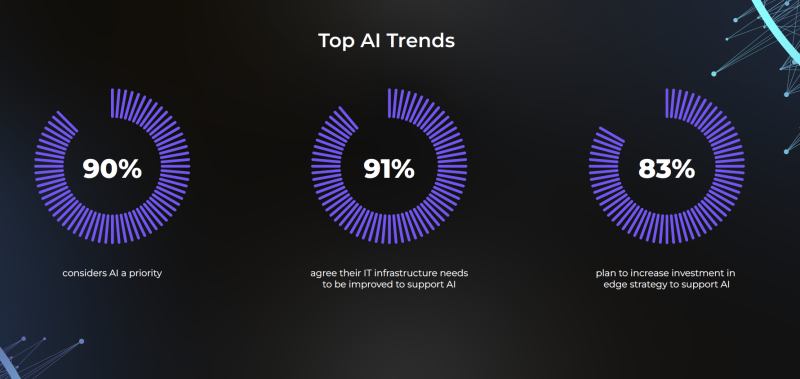-
In a new survey by Nutanix, 90% of respondents indicating that their organization considers AI a priority
-
However, 91% affirmed the need for IT infrastructure improvements to support that adoption
-
The company predicts that the push for AI adoption and the needed speed and scale to support it will move edge-focused strategies to the forefront of upgrades
IT organizations are prioritizing the adoption of AI, but their infrastructure isn’t ready for it, according to recent research from Nutanix.
Nutanix is a cloud computing company focusing on hyper-converged infrastructure (HCI), a data center architecture consolidating compute, storage, networking and virtualization resources into a single integrated system. The company’s State of Enterprise AI Report surveyed 650 decision makers across IT, DevOps and Platform Engineering to gain insight into how they are approaching AI adoption and how it impacts their spending.
The industry at large is in agreement when it comes to AI adoption, with 90% of respondents indicating that their organization considers AI a priority. However, the survey found equal unanimity (91%) in the need for IT infrastructure improvements to support that adoption, including investments in edge strategy (83%).
This contrast of prioritization and infrastructural readiness is an industry struggle that echoes other research from KPMG and studies from AMD.
Nutanix SVP Lee Caswell told Silverlinings that the last big industry “inflection point” was in cloud adoption and, furthermore the shift into hybrid- and multi-cloud environments — where organizations were looking at how to connect their on-prem data to cloud environments. “This year, we [looked at] AI because it’s such a topical interest and also a major drive of this decentralization of infrastructure,” Caswell explained.
The report found enterprises are indeed investing in running AI inferencing workloads across many environments including on-prem data centers or private clouds (59%), managed data centers or private clouds (51%), edge and remote sites (44%), single public clouds (34%) and multiple public clouds (33%).

“That was the lens on which we brought AI in; [it] was a really interesting tail end, if you will, on why data is going to be distributed,” he said.
AI where the data is
The report found that nearly all respondents (99%) are planning to upgrade their infrastructure for AI applications and over half of them indicated a need to improve the transfer of data between environments to support the successful use of AI implementations. But between cloud, data center and edge environments, companies are struggling to pave the right path forward.
The last “inflection point” noted by Caswell saw hybrid- and multi-cloud environments become the conventional IT workload infrastructure, and for this reason, Nutanix predicts that the push for AI adoption and the needed speed and scale to support it will move edge-focused strategies to the forefront of upgrades.
“You're not going to move all the data into a central application. That's not the way things are going to evolve… I'm going to apply AI at the edge because that's where the data is,” he explained. “The idea that you could do that with a common architecture that's managed identically, even though the underlying hardware elements may be different, is actually a really interesting solve for customers trying to figure out how to do this without investing in additional teams and specialized infrastructure.”
Want to discuss AI workloads, automation and data center physical infrastructure challenges with us? Meet us in Sonoma, Calif., from Dec. 6-7 for our Cloud Executive Summit. You won't be sorry.
